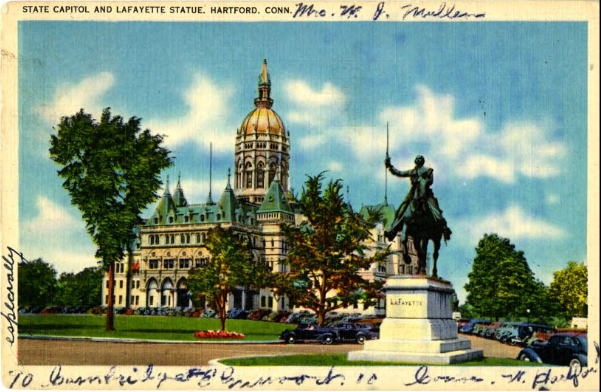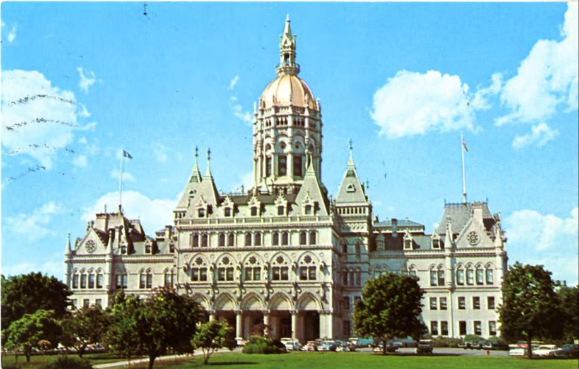Kristen Levithan
Connecticut Explored Inc.
TEACHER'S SNAPSHOT
Course Topics/Big Ideas:
State Constitution and Government
Grade:
Grade 3
Lesson Plan Notes
This interactive civics lesson is designed for students to explore the journey of a bill from an idea to a law in Connecticut. The lesson introduces students to key government concepts while engaging them in active learning. It incorporates a step-by-step breakdown of the legislative process, from idea generation to the governor’s signature. Through role-playing, students take on various roles in the legislative process, fostering a deeper understanding of how laws are made and encouraging critical thinking. This activity promotes concept application, critical evaluation, and effective communication. Students not only learn about government but also develop essential civic awareness and engagement skills.
ESSENTIAL QUESTION
SUPPORTING QUESTIONS
- What is the role of the legislative branch in Connecticut’s government?
- What is the significance of the governor’s role in the legislative process?
- How does the process of debate and voting contribute to the fairness of a law?
- How can ordinary citizens participate in the legislative process to promote fairness and balance?
ACTIVITY
Introduction
- Share images of the Connecticut State Capitol with the class. Elicit ideas from students: Does this building look familiar? What kind of things do you think happen inside? Who might live or work there?
- Ask students if they know what a “law” is. Record their responses and have a brief discussion. Explain that a law is a rule that is created and enforced by people in charge of a group. Can you give any examples of laws in our society? How about in our school or classroom? Why do we have laws?
- Explain that the images they saw earlier show the Connecticut State Capitol in Hartford, the place where legislators (lawmakers) and the governor work to make laws for our state. Share the essential question—How do we make laws that are fair?—and explain that today they will learn about how laws are made in Connecticut. They’ll even have a chance to role-play creating their own law.
Exploration
- Share the “How a Bill Becomes a Law” slideshow with the class, explaining the step-by-step process of how a bill becomes a law in Connecticut. Text to accompany each image with additional information for teachers is available in the document, “How a Bill Becomes a Law in Connecticut” handout (teacher version). A student version of the handout is also available in the toolkit.
- Encourage students to ask questions for clarification. Discuss the importance of each step in the legislative process. Why do you think there are so many steps? Emphasize the idea that laws are made to improve the lives of the people in Connecticut.
- Divide students into five small groups. Ask each group to come up with an idea for a law that they think would make Connecticut a better place to live. Have them write down their idea, creating a “bill,” and be prepared to share it with the class.
- Have the groups present their bills to their classmates. Discuss each bill as a class. How would it improve the lives of the people of Connecticut?
Application
- Choose one of the bills to illustrate the process of a bill becoming a law. (The teacher can choose one at random or choose one that seemed to have some support within the class. Alternatively, the teacher can propose a new bill [e.g., a law mandating an hour of recess time each day].)
- Explain that now students will have the chance to role-play one of the important groups involved in the legislative process. Using the same five groups students were already in for the bill-writing exercise, assign each a role: Citizens, Senators, House of Representatives, Committee Members, Governor.
- Use the slideshow and handout to guide the class through the legislative process, having the designated groups act out each step: proposing the bill, committee review, debate, voting, and signing. Encourage creativity and discussion during the role-play.
- After the group has completed the process, have a class discussion about what they learned and any challenges they faced. Revisit the potential reasons behind the many-step process and discuss the importance of cooperation and compromise.
OPPORTUNITIES FOR ASSESSMENT
- Remind students that anyone can suggest an idea for a law. Foster civic awareness and engagement by helping students understand how they can have a voice in the legislative process. Have students write a letter in which they share their ideas with their state senator or representative. (Help students find their legislators using this tool provided by the Connecticut General Assembly: www.cga.ct.gov/asp/menu/cgafindleg.asp.) This activity could be done individually, in small groups, or as a class.
- Have students write a short paragraph about what they learned from the role-playing activity and how it helped them understand the legislative process in Connecticut. Encourage them to share their reflections with their family and friends at home and ask them how they participate in state government.
- In our state, specific laws often apply to those under age eighteen. Encourage students to learn more about some important laws in Connecticut that affect children. Have students report to the class about what they have learned and share their opinions on whether they think the laws are fair. Some examples include:
- Children between the ages of five and eighteen are required to attend school.
- Children under fourteen are not allowed to have jobs (except in agriculture).
- Full-day students in Connecticut public schools must receive twenty minutes for lunch and twenty minutes for physical exercise.
- No one under the age of eighteen is allowed to vote in government elections.
RESOURCE TOOL KIT
Historic Images of the State Capitol
The Connecticut State Capitol building in Hartford is the central location where the state’s legislative process takes place. Inside, lawmakers convene to propose, debate, and pass laws, with committees reviewing bills before they reach the full chambers. The capitol also serves as the governor’s office, offers public access for participation and observation, and provides educational tours about Connecticut’s government and history.

Colourpicture/Capitol Novelty Co., “State Capitol and Lafayette statue, Hartford,” 1950, postcard. Hartford History Center, Hartford Public Library, Richard Mahoney Collection.

Natural Color Cards Co., “State Capitol at Hartford, Conn.,” 1976, postcard. Hartford History Center, Hartford Public Library, Richard Mahoney Collection.

Royal Scenics, “Civil War Memorial and State Capitol located in Bushnell Park,” 1960–1990, postcard. Hartford History Center, Hartford Public Library, Richard Mahoney Collection.
Slideshow and Accompanying Text

“How a Bill Becomes a Law” slideshow.
“How a Bill Becomes a Law in Connecticut” handout (teacher version)
“How a Bill Becomes a Law in Connecticut” handout (student version)
ADDITIONAL RESOURCES
Places to GO
Connecticut State Capitol, Hartford
The League of Women Voters of Connecticut offers free guided tours (with advance booking).
Museum of Connecticut History, located in the State Library/Supreme Court building across the street from the State Capitol, Hartford
Connecticut’s Old State House, Hartford
Things To DO
Take a virtual tour of the Connecticut State Capitol and Legislative Office Building.
Check out video tours of different areas within the Capitol and Legislative Office Building: my.lwv.org/connecticut/media/videos or youtube.com/channel/UCqnBCRnGc926JxEiuU7RLNA
Websites to VISIT
League of Women Voters of Connecticut, Teacher and Student Resources
For more on the theme of law in Connecticut history, visit ConnecticutHistory.org
Articles to READ
Lauren Remetta and Ashly Vallera, “Connecticut’s Capitol Building – Inside and Out.” ConnecticutHistory.org, May 24, 2020.
Jacob Orcutt, “Connecticut’s Old State House: Where the Constitution of 1818 Was Born.” Connecticut Explored, Fall 2018.
Walt Woodward, “Collections: The ‘Genius of Connecticut.’” Connecticut Explored, Winter 2006–2007.



